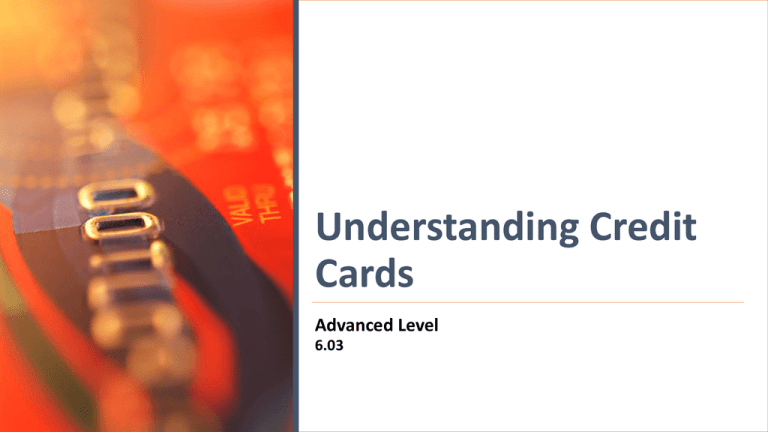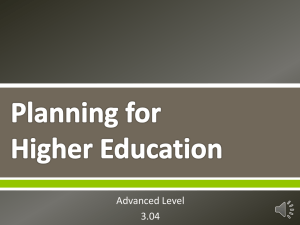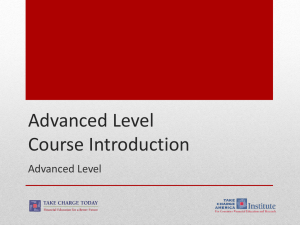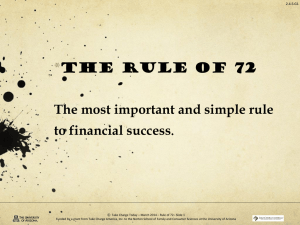Credit card
advertisement

2.6.3.G1 Understanding Credit Cards Advanced Level 6.03 © Take Charge Today – August 2013 – Understanding Credit Cards – Slide 1 Funded by a grant from Take Charge America, Inc. to the Norton School of Family and Consumer Sciences Take Charge America Institute at the University of Arizona 2.6.3.G1 What is a Credit Card? Credit card - a plastic card that you can use to access a line of credit that has been established in advance A person can borrow up to an established credit limit. Credit limit – maximum dollar amount that can be borrowed. Is a credit card open-end or closed-end credit? © Take Charge Today – August 2013 – Understanding Credit Cards – Slide 2 Funded by a grant from Take Charge America, Inc. to the Norton School of Family and Consumer Sciences Take Charge America Institute at the University of Arizona 2.6.3.G1 Credit Card Interest Interest is charged each month the balance is not paid in full Rate at which interest is charged is referred to as: Annual Percentage Rate (APR) The cost of credit expressed as a yearly interest rate © Take Charge Today – August 2013 – Understanding Credit Cards – Slide 3 Funded by a grant from Take Charge America, Inc. to the Norton School of Family and Consumer Sciences Take Charge America Institute at the University of Arizona 2.6.3.G1 Minimum Payment A minimum payment is due each month the card has a balance To prepare for her first semester of college, Miranda purchased a new computer for $1,000 and textbooks for $500, spending a total of $1,500 on her credit card charging 15% APR. How much would Miranda pay in interest if she makes the minimum payment? Payment Made Time to pay off card Total amount of interest paid Total amount paid Full Payment $1,500 1 month $0 $1,500 Partial Payment $135 1 year $125 $1,625 Minimum Payment $30 11 years $1,413 $2,913 © Take Charge Today – August 2013 – Understanding Credit Cards – Slide 4 Funded by a grant from Take Charge America, Inc. to the Norton School of Family and Consumer Sciences Take Charge America Institute at the University of Arizona 2.6.3.G1 Credit Card = Helpful Financial Management Tool …if managed responsibly Develop positive credit history Convenient payment tool Credit card safer for online shopping Protected from unauthorized charges Credit card bonuses © Take Charge Today – August 2013 – Understanding Credit Cards – Slide 5 Funded by a grant from Take Charge America, Inc. to the Norton School of Family and Consumer Sciences Take Charge America Institute at the University of Arizona Develop a Positive Credit History Credit card use can have a positive or negative impact on your credit history 2.6.3.G1 Follow these positive behaviors: Pay credit card balances in full every month Pay credit card bills on time Be conscious of how credit cards affect your credit history Check the monthly credit card statement for errors © Take Charge Today – August 2013 – Understanding Credit Cards – Slide 6 Funded by a grant from Take Charge America, Inc. to the Norton School of Family and Consumer Sciences Take Charge America Institute at the University of Arizona 2.6.3.G1 Convenient Payment Tool No need to carry large amounts of cash How is a credit card a convenient payment tool? Useful in emergencies Often required to hold a reservation Be conscientious of all credit card purchases to not overspend! © Take Charge Today – August 2013 – Understanding Credit Cards – Slide 7 Funded by a grant from Take Charge America, Inc. to the Norton School of Family and Consumer Sciences Take Charge America Institute at the University of Arizona 2.6.3.G1 Protect Yourself from Unauthorized Charges Report lost or stolen cards immediately! Maximum Liability $50 Unauthorized use Check your statements monthly! © Take Charge Today – August 2013 – Understanding Credit Cards – Slide 8 Funded by a grant from Take Charge America, Inc. to the Norton School of Family and Consumer Sciences Take Charge America Institute at the University of Arizona $0 If a lost credit card is reported before it is fraudulently used If the credit card number is used fraudulently, but the credit card itself is not used 2.6.3.G1 Safer Online Shopping What is the difference between a credit card and a debit card? More protection against fraud Credit cards are safer than debit cards Less liability for unauthorized credit card charges Money is not connected to depository institution account © Take Charge Today – August 2013 – Understanding Credit Cards – Slide 9 Funded by a grant from Take Charge America, Inc. to the Norton School of Family and Consumer Sciences Take Charge America Institute at the University of Arizona Should you choose “debit” or “credit” at a point of sale (POS)? A receipt must be signed (optional if purchase is under $25) If you pick “credit” Potential benefit: Extra liability protection from fraudulent charges Point of Sale Must enter the card’s personal identification number (PIN) If you pick “debit” Potential benefit: Option to withdraw cash from your depository institution account for no fee © Take Charge Today – August 2013 – Understanding Credit Cards – Slide 10 Funded by a grant from Take Charge America, Inc. to the Norton School of Family and Consumer Sciences Take Charge America Institute at the University of Arizona 2.6.3.G1 2.6.3.G1 Additional Benefits May charge additional fees or higher interest rates Carefully evaluate if the benefits outweigh the cost Cash rebates Rewards, Rewards, Rewards… Airline miles Warranties for items purchased Travel insurance Would you be willing to pay higher/additional fees or higher interest rates to obtain credit card benefits? Explain. © Take Charge Today – August 2013 – Understanding Credit Cards – Slide 11 Funded by a grant from Take Charge America, Inc. to the Norton School of Family and Consumer Sciences Take Charge America Institute at the University of Arizona 2.6.3.G1 Credit Cards Advantages & Disadvantages How many advantages can you think of? How many disadvantages can you think of? © Take Charge Today – August 2013 – Understanding Credit Cards – Slide 12 Funded by a grant from Take Charge America, Inc. to the Norton School of Family and Consumer Sciences Take Charge America Institute at the University of Arizona 2.6.3.G1 Credit Cards Advantages & Disadvantages • • • • • • • • Convenient payment tool Useful for emergencies Often required to hold a reservation Able to purchase “big ticket” items and spread out payments Protection against fraud Opportunity to establish a positive credit history Online shopping is safer than using a debit card Possibility of receiving bonuses • Interest can be costly when a balance is revolved • Additional penalty fees may apply • Tempting to overspend • If not used responsibly, it will have a negative impact on your credit score © Take Charge Today – August 2013 – Understanding Credit Cards – Slide 13 Funded by a grant from Take Charge America, Inc. to the Norton School of Family and Consumer Sciences Take Charge America Institute at the University of Arizona







